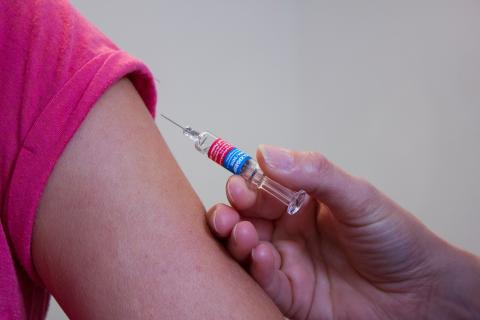
Measles, also known as rubeola, is a highly contagious, vaccine-preventable viral infection that has been under the spotlight because of the record number of cases in the United States this year. Due to a growing lack of vaccination compliance and global travel that is facilitating the spread of this highly infectious pathogen, well over 1,000 individual cases have been confirmed across at least 30 states in 2019.
Though much of the media’s attention has focused on the dangers of measles, the Maryland Department of Health notes that there have only been five cases identified in Maryland so far, all localized to a small geographic area. Still, awareness is always valuable, especially because NCI staff frequently travel.
Signs and Symptoms
Measles is an airborne disease that spreads when an infected person coughs or sneezes. The virus can live in the air for up two hours after leaving the infected person. Symptoms typically develop 10–14 days after exposure to the virus, and the contagious period begins four days before any rash appears and stretches until four days after the rash emerges.
The early symptoms of measles consist of the “three Cs”: cough, coryza (a stuffy nose), and conjunctivitis (otherwise known as pink eye). Often, they are accompanied by a high fever. Red rashes may appear on the face and can spread to the trunk and lower extremities of the body one to four days after early symptoms appear.
Along with these less-severe signs and symptoms, some people may suffer from severe complications such as pneumonia (infection of the lungs) and encephalitis (swelling of the brain). These could result in hospitalization or even death. Measles may also have an adverse effect on pregnancy, causing women to give birth prematurely or have a low-birth-weight baby.
Are Rubella and Rubeola the Same Thing?
Rubeola, also known as the “English Measles,” is the virus currently being talked about in the news, while rubella is called “German measles.” The two viral infections share similarities but also differ in a few key ways. Both are spread through coughing and sneezing, result in fever and skin rash after infection, and can only survive in human hosts. Rubella is considered a milder form and presents with a three-day rash, while rubeola is the more severe infection and presents with a seven-day rash.
Before You Travel
Exercising caution before traveling can help limit the number of travel-related cases, especially if you are traveling internationally. Getting vaccinated is the single best way to prevent infection; if you would like to get vaccinated, make an appointment with OHS or with your primary care provider.
If you are unsure whether you’ve been vaccinated or are immune to measles, you should contact your primary care provider. Evidence of measles immunity is defined as documented receipt of two immunizations of live measles virus-containing vaccine, laboratory evidence of immunity or laboratory confirmation of disease, or birth before 1957.
Doctors recommend that infants receive one dose of the measles, mumps, and rubella (MMR) vaccine between six and 11 months of age. Infants who get one dose of MMR before their first birthday should then get two more doses, one at 12–15 months of age and another dose separated by at least 28 days. It is also recommended that children 12 months of age and older receive two doses of MMR vaccine separated by at least 28 days. Teenagers and adults who do not have presumptive evidence of measles immunity should get two doses of the MMR vaccine separated by at least 28 days.
If You Think You Have Been Exposed
Once you have returned from traveling, you should monitor your health for three weeks if you think you have been exposed. Call your physician if you or your child gets sick and develops a rash or fever. Be sure to tell your doctor if you have traveled abroad.
Is Prevention Possible?
The single best way to avoid contracting measles is to get vaccinated. Then, once enough people are vaccinated, it is possible to achieve “herd immunity”—indirect protection from the virus for those who are immunized but not fully immune as well as those who cannot be immunized. In other words, high rates of vaccination decrease the odds that a vulnerable person will come in contact with an infected person. Because measles is a highly contagious virus, herd immunity requires a 96% vaccination rate. The last year that the United States achieved this rate was in 1988.
Other than vaccination, there are a few steps you can take to prevent illnesses in general. Perhaps the most important is washing your hands often with soap and water. If you’re unable to wash your hands, use hand sanitizer that contains at least 60 percent alcohol. Do not touch your eyes, nose, or mouth. If you need to touch your face, make sure your hands are clean. Cover your mouth and nose with a tissue or your sleeve (not your hands) when coughing or sneezing. Try to avoid close contact, such as kissing, hugging, or sharing utensils or cups with people who are sick.

